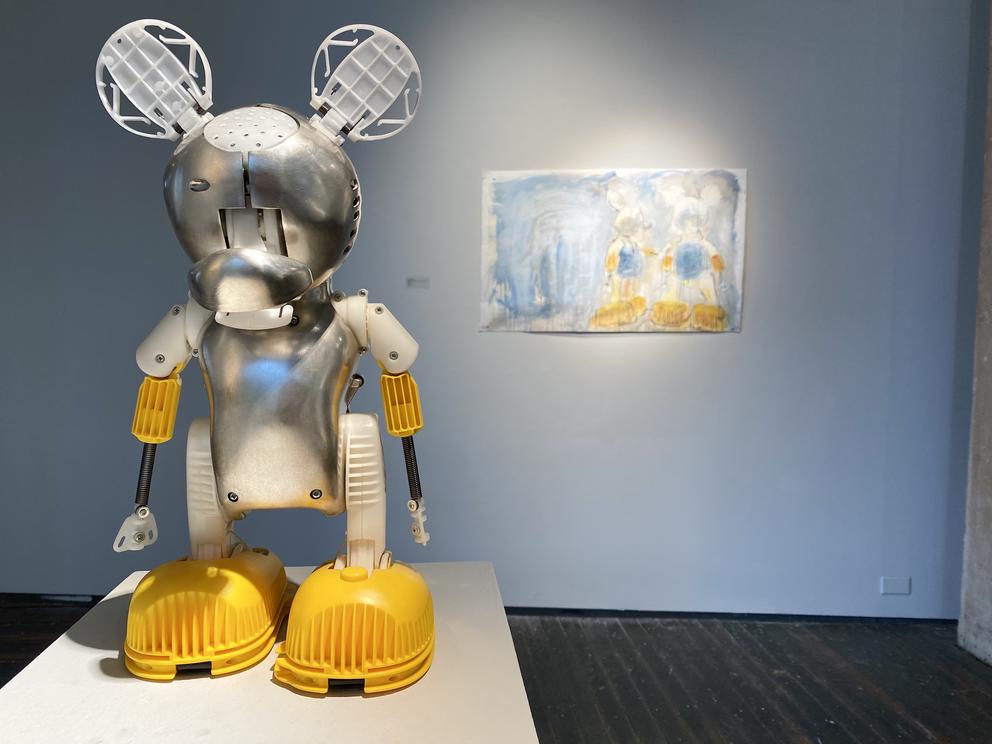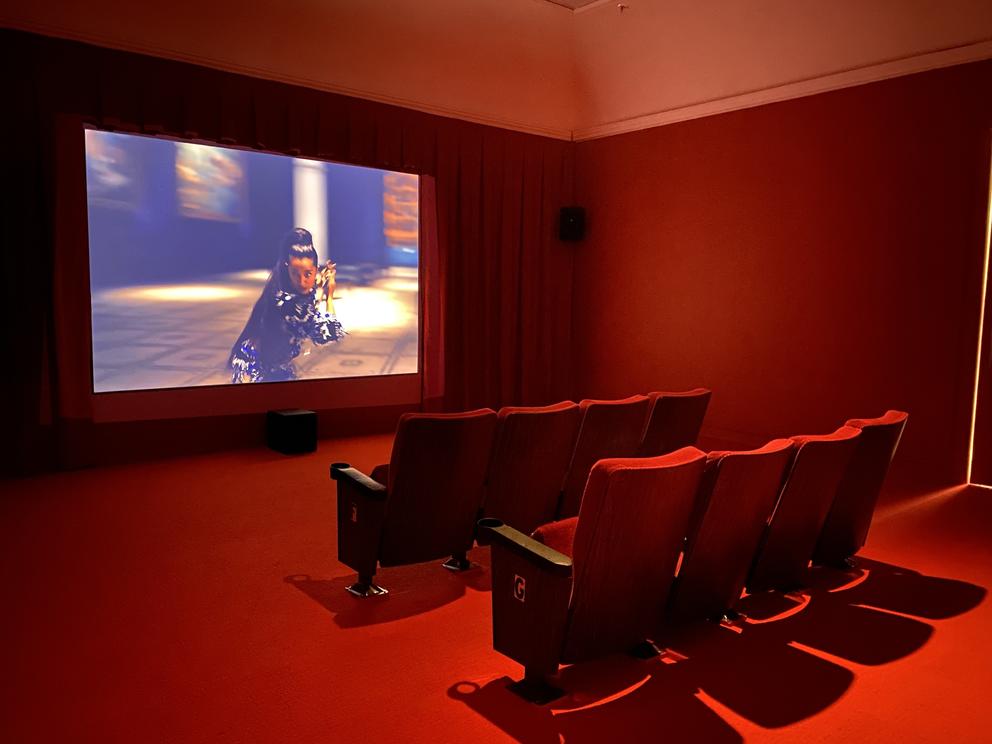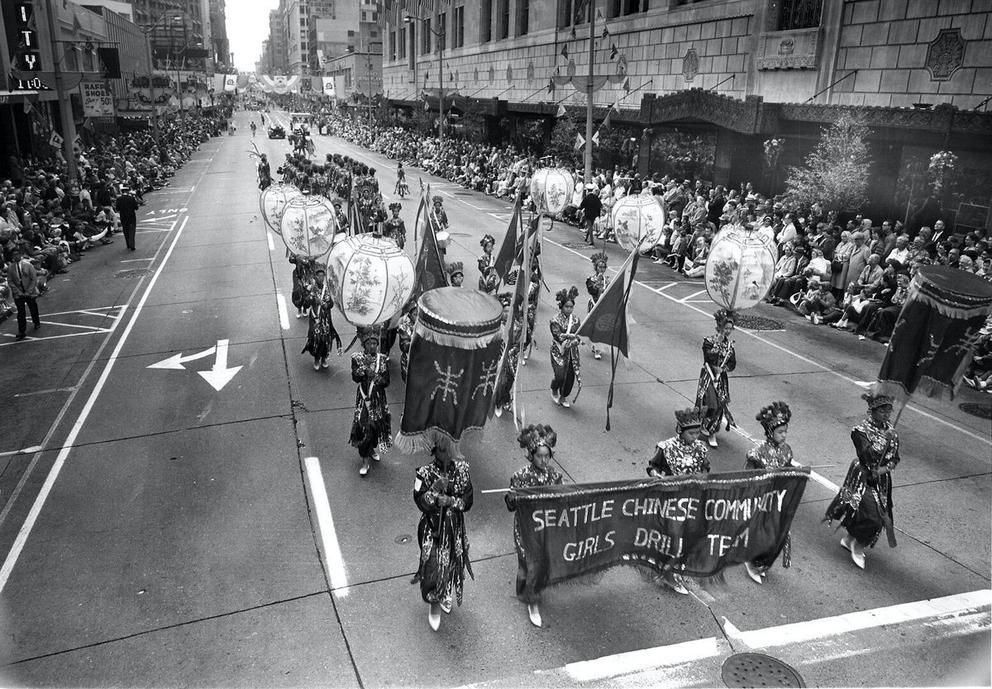In the arts, collage works the same way. An artist brings together a variety of sometimes disparate elements to spark memories, associations and surprising connections for the viewer. And you guessed it: There’s a whole lot of collaged art on view right now, revealing how the technique can manifest across different mediums.
We’ll start with bots and mutants. That’s what Seattle artist Cathy McClure calls her latest collection, Unearth (at Traver Gallery through Sept. 30).
With a background in metal design, McClure sources battery-operated stuffed toys from thrift stores, strips off the plush parts and re-casts various components (limbs, armatures) in gleaming bronze and sterling silver. She then puts them back together a la Dr. Frankenstein, reconfiguring the bodies, sometimes with parts from another toy entirely.
This menagerie of misfit toys inspires childhood nostalgia, the inherent wonder of smooth, shiny objects and a sense of something darkly animate lurking underneath — just waiting to be “unearthed.”
Pops of pink and blue plastic reveal the art of the original innards, while googly eyes and long lashes lure you close. What’s more: These anthropomorphic bots still bop.
When I visited, gallery director Sarah Traver turned on a few of the kinetic sculptures, which herk and jerk and, in the case of a haunting trio of plucked and headless roosters, squawk forlornly.
Mickey Mouse is still recognizable without his stuffing, but is transformed into a slumping misanthrope, throwing up his arms in frustration. One bot — named “QC-03” after her inspection sticker (a signifier of human acceptance) — performs a remarkably sultry shoulder shimmy.
So what are these amalgamated robots telling us? Stripped bare and given the heft of metal, they speak of past consumption and maybe a way forward, too.
You’ll find a couple more cool takes on collage in the new show Pattern, Form and Figure (at AMcE Creative Arts on Capitol Hill through Oct. 22).
This group show includes Debra Broz’s ceramic chimeras — a sort of animal collage — which she makes by painstakingly combining second-hand figurines into freaky (and funny) creatures like “Collie Pheasant,” “Rabbit Rhinoceros” and her “Avian Humanoid” series. These genetically engineered ceramic sculptures definitely want to party with Cathy McClure’s mutants.
Also featured at AMcE: New York artist Johanna Goodman, whose patchworked prints, puffy fabric pieces and textile wall hangings depict strikingly tall women whose bodies are made of crystals, feathers and colorful patterns.
At J. Rinehart Gallery in Pioneer Square, Seattle artist Kelda Martensen employs a traditional collage technique — combining digital prints, monotypes, graphite and solvent transfers. Her softly seductive pieces in Groundwork (through Oct. 7; artist talk with Kim Van Someren Sept. 23) appear both geometric and organic, evoking rivers, rocks and leafy plantscapes as well as the endpapers of exquisite books.
In Georgetown, Mutuus Studio presents the results of the most recent Recology artist residency, wherein local artists spend four months digging through detritus at the King County recycling center and turning it into art.
Resident Amanda Manitach’s resulting project, Semiotics of a Box, features physical poetry made from branding text she cut from recycled cardboard boxes. Intriguing combinations (“Plush bananas can be pumped in any position”) read like ransom notes sent from a sexy sanitation worker. Also on view are co-resident Haein Kang’s repurposed-plastic hands, sculpted from the hands of Recology workers onsite. (Sept. 16, open 1 - 5 p.m.)
And at the Henry Art Gallery, Tacoma-born Qatari American artist Sophia Al-Maria shares collaged works by way of films and “paper videos” in Not My Bag (through Jan. 14, 2024).
During COVID lockdowns, Al-Maria returned to an old favorite art form: collage, creating vibrant combinations of personal and pop-culture references using photos, fabrics, stickers, magazine pages, postcards and plastic bags.
Not My Bag features two galleries of these “paper videos” — as well as an entire immersive room that feels as if you’ve walked directly inside a collage.
Al-Maria also includes three films (each presented in very cool, stylized mini-screening rooms), which thread together found footage and scripted sections to illuminate the way fragmented and opposing cultural influences combine to create a sense of self.
If film is your preferred way to consume collaged imagery, you’ll have plenty of options at this year’s Local Sightings Film Festival (Sept. 15 - 24). This 26th annual event celebrates cinema of all sorts by Northwest filmmakers from Portland to Vancouver, B.C. One example: Canadian director Nisha Platzer’s Back Home, a pastiche of flora, Super8 and 16mm film that serves as a meditation on her brother’s suicide.
As usual, the fest features several compelling docs, including: Midsummer Night’s Dream in Prison, by recently deceased Portland filmmaker Bushra Azzouz; Before the Sun, by B.C. filmmaker Banchi Hanuse, about a Siksika woman skilled in the (traditionally male) sport of bareback relay racing; and She Marches in Chinatown, a short film by Seattle director Della Chen, about the one-of-a-kind, 70-years-strong Seattle Chinese Community Girls Drill Team.
Finally, I’ll contribute my own collage — a medley of local events highlighting the human body in motion:
Seattle contemporary dance company Whim W’Him presents its FALL ’23 show (at Erickson Theatre through Sept. 16; at Vashon Center for the Arts Sept. 19), featuring all new works by visiting choreographers Hannah Garner, Dava Huesca and Ana Maria Lucaciu.
You have a few more chances to catch the Broadway touring show of Tina: The Tina Turner Musical (at The Paramount through Sept. 17). While reportedly light on plot, narrative is perhaps not the point here — it’s the powerful music and indefatigable dancing, all in honor of the superstar’s mad talents.
And for those caught up in the battle of the paddle, Mayor Harrell and the Seattle Parks Foundation are hosting a Pickleball for All event on temporary courts set up in Downtown Seattle (Sept. 16 - 17 at Fifth Avenue and Vine Street; free with registration). Expect pickleball coaching from the Seattle Metro Pickleball Association, free play, round-robin competitions, and of course the whack of wiffle balls whizzing through the air.
Get the latest in local arts and culture
This weekly newsletter brings arts news and cultural events straight to your inbox.







